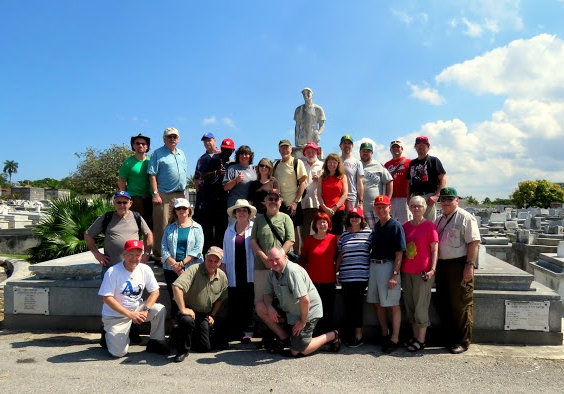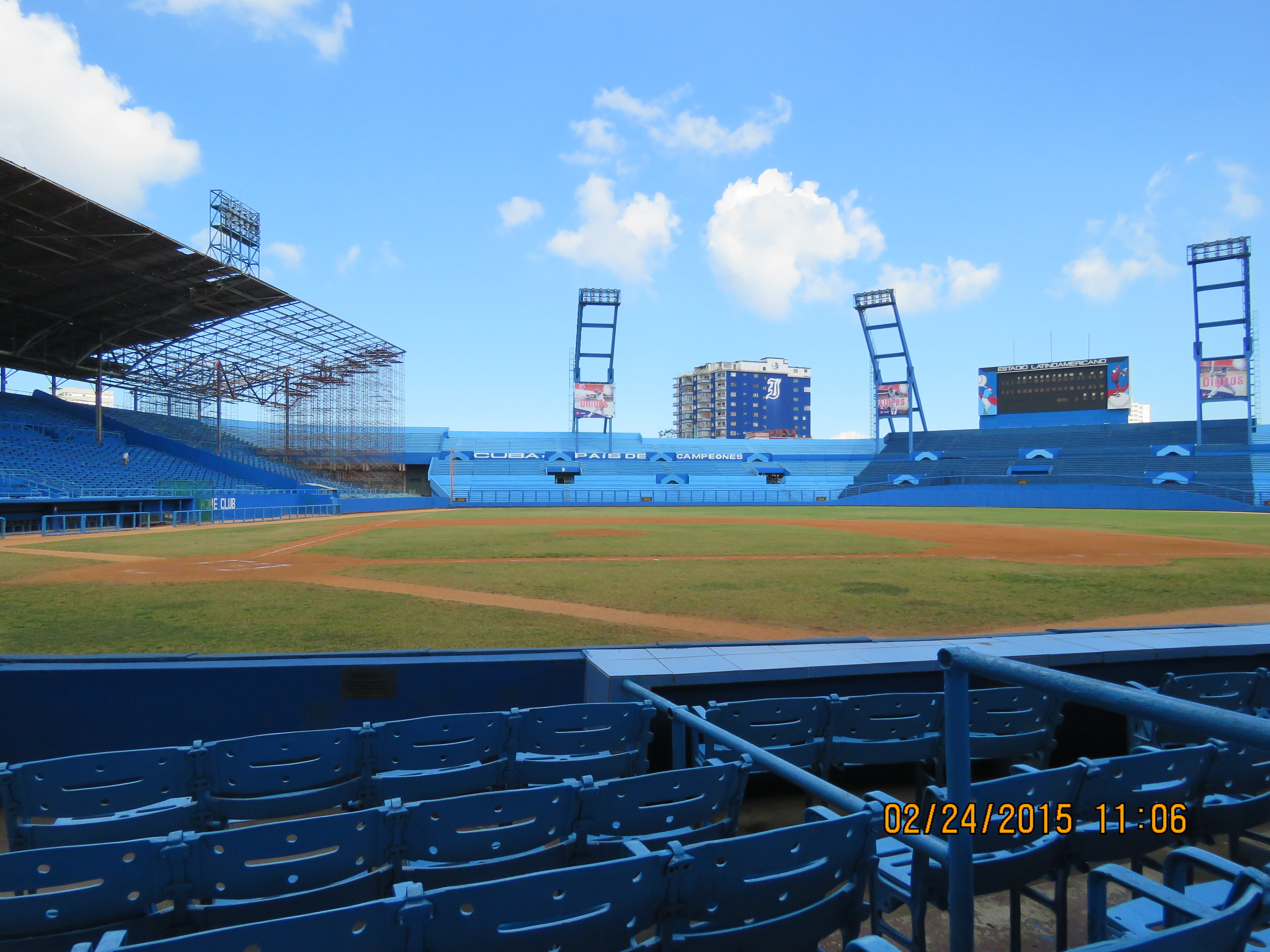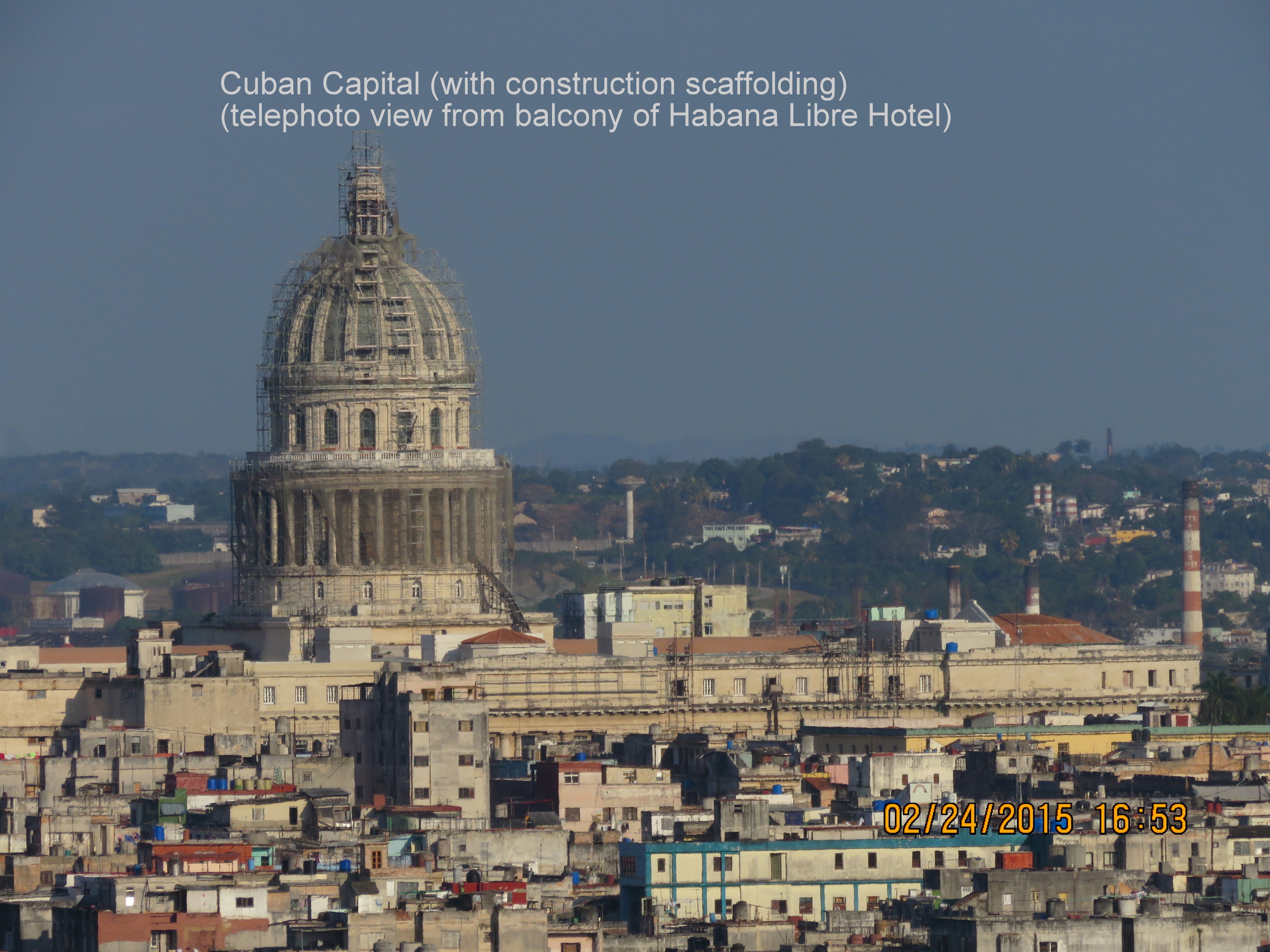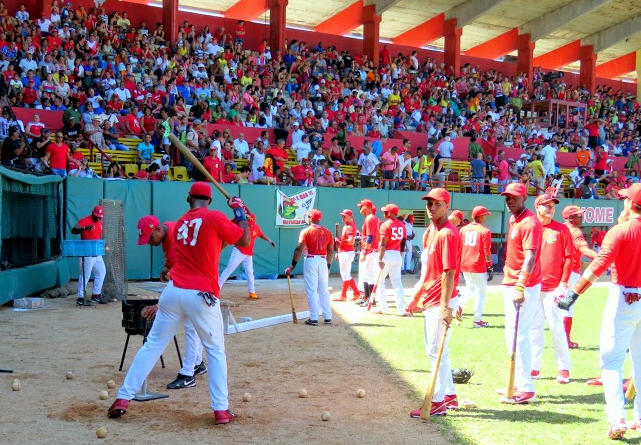Plavnick: My experience on the Cubaball tour
Editor’s note: In February 2015, Donald Plavnick of Arlington, Virginia, attended the annual Cubaball baseball tour led by SABR member Kit Krieger. Here is a personal account of his experiences. To view more photos from Plavnick’s trip, click here. For details on attending the next Cubaball tour, scroll to the bottom of this page.
By Donald Plavnick
When the average American thinks of Cuba, the thought that often comes to mind is that it is noted for good rum, good cigars, and Fidel Castro. Ask the average U.S. baseball fan about Cuban baseball and he or she will most likely cite Cuban-born stars such as Yasiel Puig and Aroldis Chapman, or Livan Hernandez and his half-brother Orlando “El Duque” Hernandez. Older fans will remember Sandy Amorós, Bert Campaneris, Jose Canseco, Mike Fornieles, Minnie Minoso, Tony Oliva, Rafael Palmeiro, Camilo Pascual, Tony Perez, Pedro Ramos, Luis Tiant, and Zoilo Versalles.
 Only a true student of the island’s rich baseball history, dating from the 1860s, is familiar with the Cuban legends of Martin Dihigo, perhaps the greatest all-around player of the Negro Leagues who starred at eight positions; he is not only in the U.S. Baseball Hall of Fame but in the baseball halls of fame in four countries. Also, Adolfo Luque, who was a star in the U.S. major leagues, winning 27 games for the 1923 Cincinnati Reds.
Only a true student of the island’s rich baseball history, dating from the 1860s, is familiar with the Cuban legends of Martin Dihigo, perhaps the greatest all-around player of the Negro Leagues who starred at eight positions; he is not only in the U.S. Baseball Hall of Fame but in the baseball halls of fame in four countries. Also, Adolfo Luque, who was a star in the U.S. major leagues, winning 27 games for the 1923 Cincinnati Reds.
It was, therefore, a learning experience of a virtually unknown but rich aspect of “our” national game for those of us making this enlightening journey to our neighbor to the south. In all, through the 2014 season, some 138 Cuban-born players have played in the U.S. major leagues (or Grandes Ligas), including 31 during the 2014 season. The list of major-league and Negro League stars that played winter ball in Cuba in the decades prior to the 1960s would fill anyone’s Hall of Fame, not to mention several Havana teams that were part of the U.S. minor leagues at various levels.
It had been a lifelong ambition to visit Cuba and now with the opportunity to attend Kit Krieger’s Cubaball tour and the prospect to see Cuban baseball firsthand — it was an experience that I could not miss. This was especially true as American citizens who travel with legal authority are not permitted to attend sporting events there. It was with a sense of changing times that I wanted to visit Cuba in its present state before the influx of American tourists turns the island into another South Miami Beach.
With the likely opening of Cuba to U.S. tourists in the coming years, the island’s infrastructure — already stretched to near limits with few hotel room vacancies during the winter — will become even more strained. Increasingly, visitors stay in state-sanctioned private homes, known as casas particulares. While hotel rooms can still be found for around $100 per night when available, it is believed by some observers they will cost as much as $400 in a few years as more American tourists visit. Additionally, many of the best restaurants in Havana are run from private homes, with state approval, providing a tastier fare than can be commonly found in the island’s standard restaurants with their food shortages.
Another incentive was the opportunity for many of us to escape the harsh winter of the northern U.S. and Canada for a week in the tropics. Though Havana and parts of Cuba occasionally experience cold snaps with temperatures falling into the 40s, during our stay it remained sunny and warm with temperatures in the 70s in Havana and near 90 at the eastern beaches.
The Cubaball tour is an annual visit that has been occurring for more than a dozen years, devoted to seeing and learning about baseball in Cuba, attending games in Havana and around the country during their season-ending Serie Nacional, which began in 1962 with the elimination of professional sports in Cuba. It is not a formal SABR-sponsored event, but more than half of the 25 attendees are SABR members and is informally promoted through SABR. About a third of the participants were Canadians. Many of our group had made multiple visits to Cuba. The trip is organized and led by SABR member E.J. “Kit” Krieger, a former employee of the Pacific Coast League’s Vancouver Mounties under manager Mickey Vernon who was given the opportunity to pitch in the final game of their 1969 season.
 In Havana, we stayed at the Hotel Habana Libre, which opened as the Havana Hilton, the Hilton chain’s newest hotel, just months before the entry of a triumphant Fidel Castro into Havana. The hotel, as with all others, was soon commandeered by the Revolution and served as Castro’s headquarters for several months in 1959. His actual suite, the de facto White House and Capitol building of Cuba, was just down the hall from my room on the 23rd floor. No sign marks its historical past and it is rented to present-day guests.
In Havana, we stayed at the Hotel Habana Libre, which opened as the Havana Hilton, the Hilton chain’s newest hotel, just months before the entry of a triumphant Fidel Castro into Havana. The hotel, as with all others, was soon commandeered by the Revolution and served as Castro’s headquarters for several months in 1959. His actual suite, the de facto White House and Capitol building of Cuba, was just down the hall from my room on the 23rd floor. No sign marks its historical past and it is rented to present-day guests.
Just a few blocks away is the world-famous Hotel Nacional, a landmark that opened in 1930. From its opening through the 1960s its guest list was a Who’s Who of the world’s famous in all walks of life, film, entertainment, sports, diplomats, world leaders, and gangsters. Their pictures, arranged by decade, adorn the walls of the hotel’s classic bar, including Stan Musial and Mickey Mantle.
During the Cubaball trips, visits are made with various teams at the stadiums and clubhouses, with interviews with former Cuban baseball stars (some of whom played Major League Baseball) and a visit to a state-run youth baseball academy. This was only the second trip where licenses from the U.S. Treasury Department were provided for all U.S. travelers. On this trip 25 of us — including at least 14 SABR members, some who have authored numerous books on baseball — saw six games of the Serie Nacional in five different cities and stadiums (Havana, Matanzas, Holguin, Bayamo, and Artmisa.)
Our group had behind-the-scenes personal tours of what passes for the clubhouse, the dugout, on-field access during pre-game workouts, and photos with the teams on the field. We were privileged to have several meetings with the Matanzas manager, the local legend Victor Mesa, “El Loco,” who was one of the greatest baserunners in Cuban baseball and a star in several Serie Nacional and World Cup matches.
Each year, our group brings U.S.-made baseball equipment for the teams and youth leagues, although Cuba has been producing its own baseballs and bats for several decades now. Our group of Americans and Canadians made quite a stir when we sang “Take Me Out to the Ballgame” in English during the seventh innings of all the games we attended. It even appeared on Cuban TV. Serie Nacional games are televised live in Cuba and they have access to U.S. Major League games, mainly through a telecast of one game a week and they are well aware of what’s going on in the Ligas Mayores de Norteamericano, or Grandes Ligas. However, references to Cuban-born players are carefully avoided. Relatives visiting from the United States keep them apprised of the latest events as well as bringing them televisions they could never buy or afford in Cuba to watch games.
 Even though it was the playoffs, attendance ranged from not more than a laconic couple of hundred at small ballparks to a raucous, non-stop horn-blowing capacity crowd at a 30,000-seat stadium. Seating ranged from standard stadium seats to step-like concrete slabs. Tickets to all games in Cuba cost the equivalent of 75 U.S. cents. From 1967 until about 1997, all games were free. All balls hit into the stands, including home runs, are thrown back by the fans. The stadium lights went out for 30 minutes at one night game we attended but that occasionally happens in the States, also, and the team’s uniformed “mascot” entertained during the break.
Even though it was the playoffs, attendance ranged from not more than a laconic couple of hundred at small ballparks to a raucous, non-stop horn-blowing capacity crowd at a 30,000-seat stadium. Seating ranged from standard stadium seats to step-like concrete slabs. Tickets to all games in Cuba cost the equivalent of 75 U.S. cents. From 1967 until about 1997, all games were free. All balls hit into the stands, including home runs, are thrown back by the fans. The stadium lights went out for 30 minutes at one night game we attended but that occasionally happens in the States, also, and the team’s uniformed “mascot” entertained during the break.
The field lighting for night games appeared similar to minor-league stadiums in the States and the field conditions appeared to be at least as good as the U.S. minor leagues. Some of the game baseballs didn’t appear too new and pre-game warmup balls appeared quite worn. Stadium scoreboards are just a touch better than at most U.S. minor league stadiums but with no player pictures.
Early arrivals on the tour attended a game at Havana’s redoubtable Estadio Latinoamericano, the home of Havana’s two major teams, the Los Industriales and the Los Metropolitanos. Nearby large apartment buildings are painted in the colors of the two teams. This classic stadium, the scene of numerous important games, opened in 1946 as “Cerro” or “Gran Stadium” and is older than all but two Major League parks, Fenway Park and Wrigley Field. It was renamed by the Revolution and remodeled in the early 1970s.
Like we do at many SABR Conventions, we had a tour of historic stadium sites in Havana, including the historic Estadio la Tropical, or Tropical Stadium. Most of the original stands remain but the ballfield is now a field track. A bronze plaque commemorates the stadium as the site of the first Amateur Baseball World Series to be played in the Americas, in August 1939, on the eve of WWII. Cuba won the series, six games to none.
As with many things in Cuba, even the scoreboards are political. Some of the stadiums are named after Cuban heroes or events and adorned with pictures of Fidel Castro taking command at the 1961 Bay of Pigs invasion. Even the runs-hits-errors tabulation on the scoreboard is arranged to spell out the popular nickname of revolutionary hero Ernesto “Che” Guevara, by listing the traditional “R-H-E” as “C-H-E”, (Carrera-runs, hits, errors; they use the English spelling for some baseball references.)
Most of the non-Cuban baseball experts believe their playing level is generally around Class AA in our minors, with the best teams perhaps at Triple-A level. They use the DH and one nine-inning game we attended lasted almost four hours. We did see one nicely executed 6-3 triple play. Unlike in the U.S., team members are almost exclusively from the geographical area of the team they play for. The very top players receive some type of financial subsidy and housing provisions, and are quite well off compared to many of their countrymen.
In past years, the “Cubaballers”, or “Cubaballistas” — as our tour group proudly calls itself — used to visit former Senators pitcher, the late Connie Marrero, a beloved legend in his native Cuba, at his home and were always welcomed by him. Connie was an established star in Cuba in the late 1930s through the mid-1940s, long before he joined the Washington Senators. On visits to his home, he would have a cigar in his hand and when asked about the key to his pitching success, he would gruffly say in his limited English, “slider”, while gesturing the delivery. This last year, some of the group visited his family. I was fortunate enough to purchase (for $30 U.S.) one the last 12 baseball cards personally signed by Connie, a locally produced set created several years ago and neatly signed by him (with assistance), though he was nearly 100 years old and totally blind through a botched double cataract surgery. The proceeds go to his family.
Also with us was SABR member Peter C. Bjarkman, likely the foremost living authority on Cuban baseball and who has effectively debunked the urban legend and long-standing myth of Fidel Castro’s baseball ability and almost being signed by the Washington Senators and several other teams. He is the author of A History of Cuban Baseball, 1864-2006, perhaps the definitive history of Cuban baseball and a must-read for anyone with interest in the subject. Peter, who speaks fluent Spanish, is well-known by the Cuban baseball community and was our “ambassador” to the local teams, players, and former stars.
We were completely free at all times to walk around Havana and other cities wherever we wanted and take pictures of anything we wanted; however, local Cuban citizens are prohibited from going inside tourist hotels or stores unless they work there. The authorities seem more concerned with the conduct of their own citizens rather than with foreign tourists. Coming back into the U.S. at various ports of entry, no one in our group had any problems or questions from U.S. Immigration, though we all had printed licenses from the U.S. Treasury Department’s Office of Foreign Assets Control authorizing our trip.
 Tourism by U.S. citizens is still not permitted but our trip fell under one of the 12 officially sanctioned categories of people-to-people and/or educational categories. Cuban immigration authorities normally do not stamp U.S. passports on entry and exit, but because of this waiver many of the U.S. visitors specifically asked for their passports to be stamped with the Cuban visa as a souvenir.
Tourism by U.S. citizens is still not permitted but our trip fell under one of the 12 officially sanctioned categories of people-to-people and/or educational categories. Cuban immigration authorities normally do not stamp U.S. passports on entry and exit, but because of this waiver many of the U.S. visitors specifically asked for their passports to be stamped with the Cuban visa as a souvenir.
It is still against U.S. law tied to the embargo for American citizens living in the United States to import rum and cigars, the two products for which Cuba is world-renowned. The better Cuban cigars that sell for the U.S. equivalent of about $37 each in Cuba can cost $2,000 for a small box in Canada. It is no secret that American citizens find creative ways of bringing those products into the U.S., usually through Canada.
One of the most iconic symbols in Cuba, especially Havana, is the preponderance of classic, early 1950s American automobiles. Almost every make, model, year, and color can be seen on the streets and country roads. Along with the colonial-style buildings, it’s like going back in time. Although you see them in every travelogue or story on Cuba, seeing them in person is a memorable experience. Visitors of a certain age (to include many SABR members) will have nostalgic memories of their childhood. Many are lovingly preserved, washed, and waxed as if they had just been driven off the showroom floor.
Many of these classic vehicles are used for public taxis in Havana, and are popular with North American tourists. Others are in such a state of disrepair as to appear to be held together only by their rust. However, with an embargo-induced shortage of parts, it requires constant mechanical creativity with largely Russian-made parts to maintain them. Some owners remove the engine each night to prevent theft, though the crime rate is exceptionally low or a city of that size. Most of the operable vehicles are Russian-made.
Sports memorabilia was all but nonexistent. Other than Las Americas Stadium in Havana that sold replica caps and jerseys of Cuban teams, not even programs or scorecards were available. They say there is a paper shortage and officially there have been no professional sports, including baseball, in Cuba since 1962. In the downtown public market book stalls, one can occasionally find 1950s-era Cuban and U.S. baseball publications.
This in no way dampens the fervor, or knowledge, of local residents. Every day an enthusiastic group of Habaneros gather in Parque Central, the central park across from the Capitol building in Havana, in an area known throughout Cuba as La Esquina Caliente, or “the hot corner,” and have animated discussions about players and teams. They are issued special ID badges by the government allowing them to assemble publicly in large numbers.
Although older Cubans are very familiar with pre-Revolution baseball and talk about it all the time, the official government line is to ignore those pre-1962 players and teams. No Cuban playing in the U.S. is officially recognized, even those who played long before the Revolution. There is a very rudimentary all-sports Hall of Fame of mainly post-1962 amateurs and though U.S. visitors have been working with locals to reestablish one, it is not being openly welcomed by local authorities.
Immediately after games, some players came out directly to our bus and literally sold us the game-worn jerseys off their backs, generally for the equivalent of $30-50 U.S., a significant profit for them. Our group spent several hundred dollars on these jerseys. Our tour leader tried to obtain for us the printed rain checks from the games we attended as souvenirs, but they were unavailable as the stadium attendants kept them for themselves to re-sell the same seats for personal profit. I’ve heard it said by experienced travelers that postal workers will sometimes tear the stamps off letters and postcards being mailed and re-sell them. The post cards I and others sent, while still retaining their stamps, had no cancellation on them and took on an average two months to arrive in the U.S.
We brought many Major League Topps baseball cards, especially those of Cuban-born players, to give out to the kids at the ballpark. Though our U.S. and Canadian tour leaders warned about the chaos that would ensue if we gave them out there, it immediately drew smarms of children. Any U.S.-related baseball item, especially involving native Cubans, is widely popular.
We visited a state-run baseball academy in Bayamo, not far from the Bay of Pigs, where hand-picked talented young players from Little League-age on up are trained for baseball careers. The baseballs they were using were so worn, the covers were literally coming off. That is why our group brings them dozens of new U.S. baseballs and equipment each year.
American tourists are genuinely popular in Havana and throughout Cuba, and not just for the prospect of an improved standard of living if the embargo is lifted. I personally encountered warm welcomes from cab drivers, hotel employees, and security personnel at the airports. American flags are beginning to appear in stores, restaurants, and some buildings in and around Havana.
Revolutionary billboards, posters, murals, and slogans espousing quotations and exhortations of Fidel Castro, Che Guevara and other heroes of the Revolution still abound but they are fading with age and no longer carry the harsh anti-U.S. invective of the past. Even the English-language shortwave broadcasts on Radio Havana greatly downplay the longstanding adversarial relationship between the two countries and play up the hoped-for positive elements.
It is interesting to note that pictures and references of Che Guevara greatly outnumber those of Fidel Castro, with Che’s visage everywhere, on T-shirts, book covers, tourist items, billboards and even an immense multi-story metal portrait of him on the side of a government building, while references and pictures of Fidel are older and not nearly as prevalent. The current president and Fidel’s younger brother, Raul Castro, is virtually unseen. It is easier to glorify someone who can no longer be blamed for present conditions. Today, Che Guevara has become more of a pop culture icon and less of a historical figure among generations of younger Cubans who did not know him. Guevara, a native of Argentina, left Cuba in 1965 and was killed in Bolivia in 1967.
To be sure, there are still some hardline communist stalwarts. Some of the older Revolutionaries oppose re-establishment of relations with the U.S. because it could threaten the continuance of the regime and the government could no longer blame all their problems on the United States. Illustrative of this, during one trip on another part of the island, our tour bus stopped at a small local grade school to donate some supplies, in concert with our people-to-people mission enabling us to travel in Cuba legally. The school mistress, a middle-age dedicated communist revolutionary, refused to accept anything from Americans or Canadians, no matter how badly needed. To get around this, our tour leader, a native Cuban, informed her that we were British citizens. Then she readily accepted our donation.
This was not an inexpensive trip. Including everything, the tour fee, game tickets, hotels, meals, bus trips, tour guides, internal flights in Cuba, flights to and from Cuba, flights and hotels to and from cities we had to go to fly into Havana (non-Cubans or Americans still cannot travel directly from the U.S. to Cuba), gratuities, and donations, it ran to $4,000 to $5,000 per person. I think we all agreed it was well worth the expense and many of us look forward to a return trip sooner than later. Politics aside, I heartily recommend it to anyone whose budget can accommodate it.
Cubaball Tours will take its 14th annual baseball tour of Cuba from October 17 to 24, 2015. Cubaball offers a varied itinerary including unparalelled access to veteran and current players, journalists, and Cuban officials. The tour visits historic sites, including the Hemingway estate, the Finca Vigia, La Tropical Stadium, home of the Cuban winter league from 1930 to 1946, and the baseball monuments in Havana’s Latin American Stadium. The tour also includes seminars on Cuban politics, economics, foreign policy, and culture. Contact Kit Krieger at ejkrieger@shaw.ca for more information.
Originally published: July 22, 2015. Last Updated: July 22, 2015.


